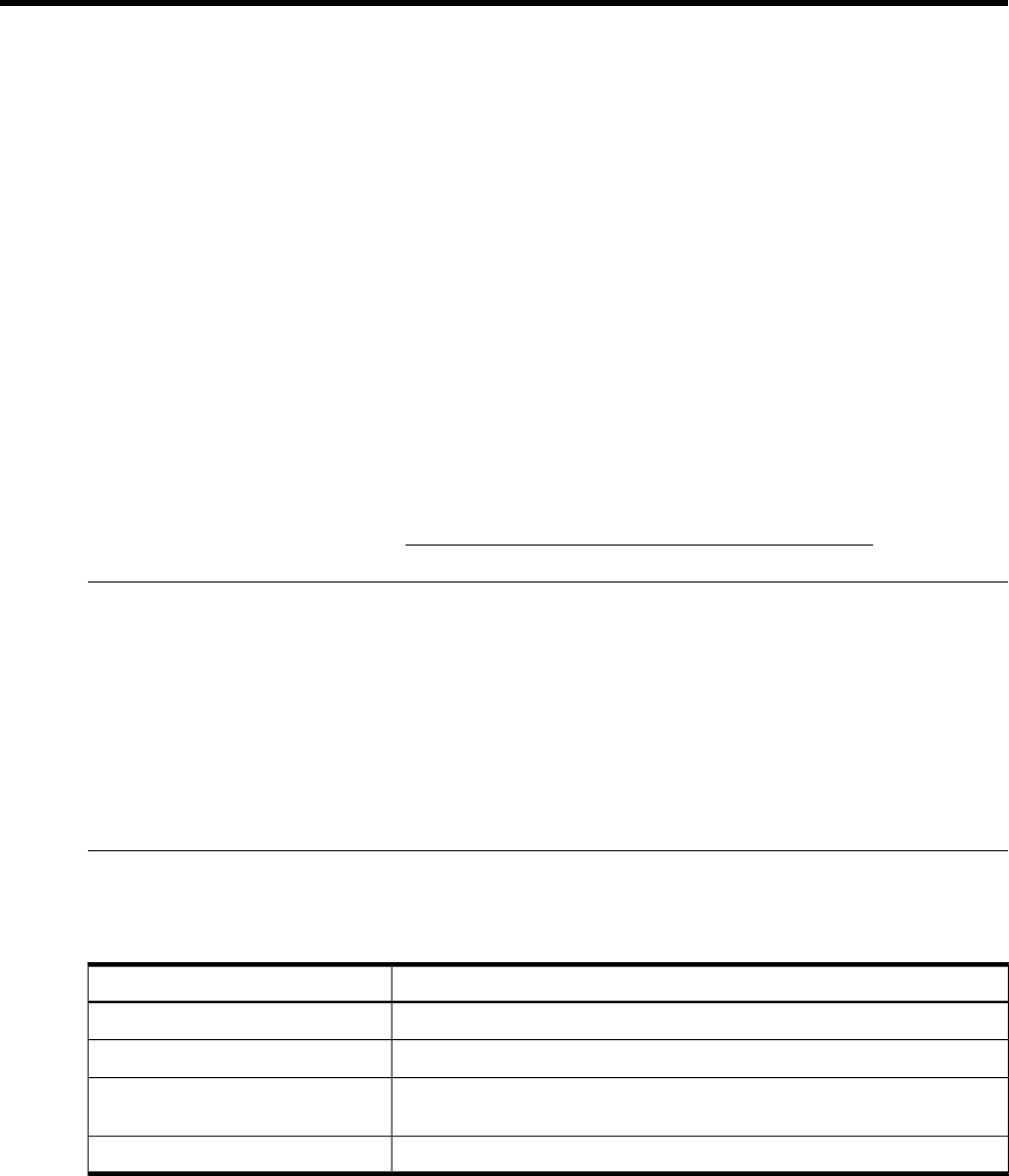HP Serviceguard Enterprise Cluster Master Toolkit User Guide (5900-2145, April 2013)
Table Of Contents
- HP Serviceguard Enterprise Cluster Master Toolkit User Guide
- Contents
- 1 Introduction
- 2 Using the Oracle Toolkit in an HP Serviceguard Cluster
- Overview
- Supported Versions
- Support for Oracle Database Without ASM
- Supporting Oracle ASM Instance and Oracle Database with ASM
- What is Automatic Storage Management (ASM)?
- Why ASM over LVM?
- Configuring LVM Volume Groups for ASM Disk Groups
- Sample command sequence for configuring LVM Volume Groups
- Serviceguard support for ASM on HP-UX 11i v3 onwards
- Framework for ASM support with Serviceguard
- Installing, Configuring, and Troubleshooting
- Setting up DB instance and ASM instance
- Setting up the Toolkit
- ASM Package Configuration Example
- Modifying a Legacy Database Package Using an Older Version of Oracle ECMT Scripts to use the Scripts Provided for ASM Support
- Adding the Package to the Cluster
- Node-specific Configuration
- Error Handling
- Network Configuration
- Database Maintenance
- Configuring and packaging Oracle single-instance database to co-exist with SGeRAC packages
- Configuring Oracle single-instance database that uses ASM in a Coexistence Environment
- Attributes newly added to ECMT Oracle toolkit
- Configuring a modular failover package for an Oracle database using ASM in a coexistence environment
- Configuring a legacy failover package for an Oracle database using ASM in a Coexistence Environment
- ECMT Oracle Toolkit Maintenance Mode
- Supporting EBS database Tier
- Oracle ASM Support for EBS DB Tier
- 3 Using the Sybase ASE Toolkit in a Serviceguard Cluster on HP-UX
- Overview
- Sybase Information
- Setting up the Application
- Setting up the Toolkit
- Sybase Package Configuration Example
- Creating the Serviceguard package using Modular method
- Adding the Package to the Cluster
- Node-specific Configuration
- Error-Handling
- Network configuration
- Database Maintenance
- Cluster Verification for Sybase ASE Toolkit
- 4 Using the DB2 Database Toolkit in a Serviceguard Cluster in HP-UX
- 5 Using MySQL Toolkit in a HP Serviceguard Cluster
- MySQL Package Configuration Overview
- Setting Up the Database Server Application
- Setting up MySQL with the Toolkit
- Package Configuration File and Control Script
- Creating Serviceguard Package Using Modular Method
- Applying the Configuration and Running the Package
- Database Maintenance
- Guidelines to Start Using MySQL Toolkit
- 6 Using an Apache Toolkit in a HP Serviceguard Cluster
- 7 Using Tomcat Toolkit in a HP Serviceguard Cluster
- Tomcat Package Configuration Overview
- Multiple Tomcat Instances Configuration
- Configuring the Tomcat Server with Serviceguard
- Setting up the Package
- Creating Serviceguard Package Using Modular Method
- Setting up the Toolkit
- Error Handling
- Tomcat Server Maintenance
- Configuring Apache Web Server with Tomcat in a Single Package
- 8 Using SAMBA Toolkit in a Serviceguard Cluster
- 9 Using HP Serviceguard Toolkit for EnterpriseDB PPAS in an HP Serviceguard Cluster
- 10 Support and Other resources
- 11 Acronyms and Abbreviations
- Index

7 Using Tomcat Toolkit in a HP Serviceguard Cluster
This chapter describes the toolkit that integrates and runs HP Tomcat in the HP Serviceguard
environment. It is intended for users who want to install, configure, and execute the Tomcat servlet
engine application in a Serviceguard clustered environment. To use this document, you must be
familiar with Serviceguard and the Tomcat Servlet engine, including installation, configuration,
and execution.
This toolkit supports:
HP Serviceguard versions:
• A.11.19
• A.11.20
Tomcat version that is available with HP Web Server Suite (WSS)
• 2.X and 3.X
HP-UX 11i v2 and HP-UX 11i v3
This version supports A.11.19 and A.11.20 versions SG, application, and HPUX versions. More
recent versions of these products are certified with B.06.00. For the latest information, see the
compatibility matrix available at: http://www.hp.com/go/hpux-serviceguard-docs —>HP
Serviceguard .
NOTE: This version of the toolkit supports both legacy and modular style packages.
The Tomcat toolkit supports all filesystems, storage, and volume managers that Serviceguard
supports other than CFS.
This toolkit consists of a set of shell scripts for configuring, starting, monitoring, and stopping the
Tomcat Servlet engine application. The toolkit works with the Serviceguard package control script,
managed by Serviceguard for legacy packages or the Serviceguard master control script for
modular packages. Each Tomcat instance is configured in its own Serviceguard package.You must
be familiar with swinstall to properly install both Serviceguard and the ECMT which includes the
scripts for Tomcat.
During installation, you can use the files, listed in Table 26 (page 110). They are located in: /opt/
cmcluster/toolkit/tomcat
Table 26 Files in Tomcat Toolkit
DescriptionFile Name
User defined variables for customizing this toolkit for your environment.hatomcat.conf
The script that monitors the health of the Server application.hatomcat.mon
The interface between the package control script and the Tomcat Toolkit main
shell script.
toolkit.sh
This script generates Alert mails in case of package failure.SGAlert.sh
The three files listed in Table 27 (page 111) and Table 28 (page 111) are also installed and are
used only for the modular method of packaging.
The following Attribute Definition File (ADF) is installed in /etc/cmcluster/modules/ecmt/
tomcat.
110 Using Tomcat Toolkit in a HP Serviceguard Cluster










